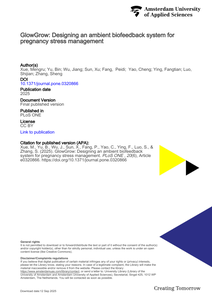Anxiety among pregnant women can significantly impact their overall well-being. However, the development of data-driven HCI interventions for this demographic is often hindered by data scarcity and collection challenges. In this study, we leverage the Empatica E4 wristband to gather physiological data from pregnant women in both resting and relaxed states. Additionally, we collect subjective reports on their anxiety levels. We integrate features from signals including Blood Volume Pulse (BVP), Skin Temperature (SKT), and Inter-Beat Interval (IBI). Employing a Support Vector Machine (SVM) algorithm, we construct a model capable of evaluating anxiety levels in pregnant women. Our model attains an emotion recognition accuracy of 69.3%, marking achievements in HCI technology tailored for this specific user group. Furthermore, we introduce conceptual ideas for biofeedback on maternal emotions and its interactive mechanism, shedding light on improved monitoring and timely intervention strategies to enhance the emotional health of pregnant women.
DOCUMENT

Pregnancy can be challenging for women as they experience various physical, psychological, and social changes that can lead to stress and potential mental health concerns. Being neglected in the long-term, sustained stress can increase the likelihood of postpartum depression, which can have significant negative impacts on mothers, families, and society. Therefore, managing stress promptly and maintaining emotional well-being is crucial for pregnant women to give a healthy birth and improve their postpartum life quality. Biofeedback is a secure and effective treatment for anxiety; nevertheless, conventional biofeedback systems often depend on intrusive sensors and require clinician support, thereby restricting their utilization primarily to clinical settings. To address this challenge, in this study, by incorporating biofeedback techniques with wearable sensors, musical displays, and ambient light, we created an immersive biofeedback environment where pregnant women could practice slow-paced resonant breathing to promote relaxation and reduce stress. GlowGrow system has been deployed in a regional hospital’s ante-natal clinic and evaluated by 24 pregnant women regarding its effectiveness and user experience. The results show that GlowGrow, as an effective relaxation intervention, could efficiently guide pregnant women to perform deep breathing and manage physiological stress.
DOCUMENT

With the increased adoption of real-time objective measurements of player experience, advances have been made in characterising the dynamically changing aspects of the player experience during gameplay itself. A direct coupling to player action, however, is not without challenges. Many physiological responses, for instance, have an inherent delay, and often take some time to return to a baseline, providing challenges of interpretation when analysing rapidly changing gameplay on a micro level of interaction. The development of event-related, or phasic, measurements directly coupled to player actions provides additional insights, for instance through player modelling, but also through the use of behavioural characteristics of the human computer interaction itself. In this study, we focused on the latter, and measured keyboard pressure in a number of different, fast-paced action games. In this particular case, we related specific functional game actions (keyboard presses) to experiential player behaviour. We found keyboard pressure to be higher for avoidance as compared to approach-oriented actions. Additionally, the difference between avoidance and approach keyboard pressure related to levels of arousal. The findings illustrate the application potential of qualifying players’ functional actions at play (navigating in a game) and interpret player experience related to these actions through players’ real world behavioural characteristics like interface pressure.
MULTIFILE
